The Ultimate Guide to Solar-Powered Sign Lighting Solutions
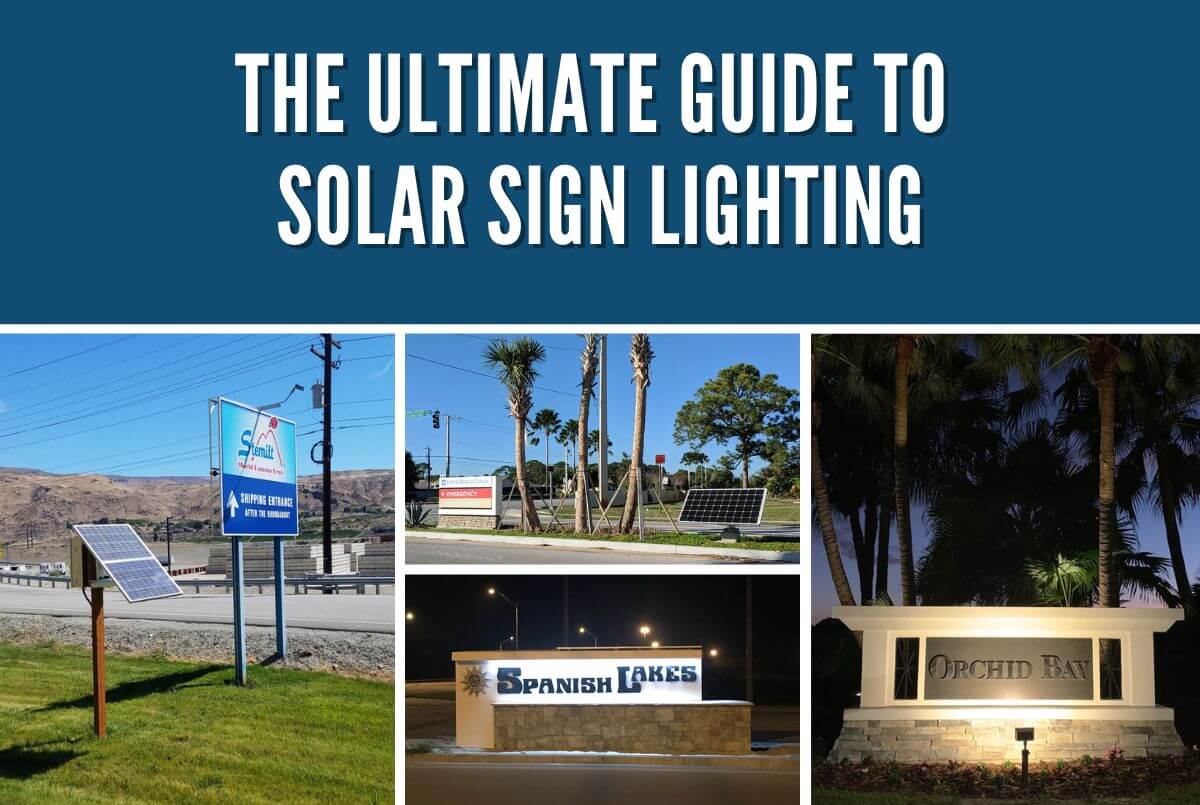
Contents
Signs are used around the world to convey information and communicate with people. Signs can be used to show a location, mark an entrance or exit, give directions, or provide helpful information to people passing by. Some signs require illumination to allow people to see the sign at night, others are made from reflective materials, and many are just not illuminated at all for one reason or another.
This guide will walk you through the various types of signs, how you can illuminate them, how solar plays a part in the illumination of a sign, how to size up a solar solution, and finally a comparison between commercially designed custom solutions to solar lights you can find at any big box retailer. We hope this guide gives you a comprehensive understanding of signs and how they should be illuminated.
What Makes a Sign
There are so many types of signs. In this section, we will cover signs that require illumination in one way or another. This doesn't necessarily mean that each one will have a lighting requirement, but these are the most common signs that require a light system, whether standard electric or solar-powered.
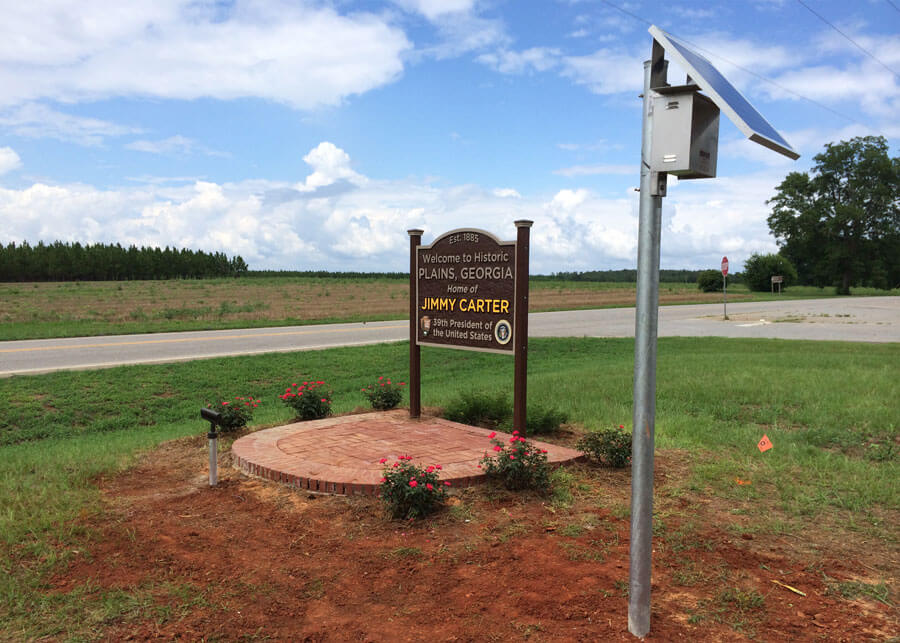
Small Directional/Wayfinding Signs
Most small directional or wayfinding signs are designed to guide people by providing essential information about a specific site, such as a mall, shopping center, community, or even a drive-through. They achieve this by incorporating simple elements such as arrows pointing towards a particular direction or marking a significant spot requiring attention. These signs often indicate the entrance or exit of a location, ensuring that individuals can navigate the area with ease and confidence.
These signs are typically quite compact, measuring around 5 feet square or smaller. Due to their functional nature, they aren't typically adorned with decorative elements, focusing instead on clarity and effectiveness.
In terms of lighting, they usually require only a small light fixture or a few LED modules inside a cabinet to adequately illuminate the information they display, ensuring visibility during low-light conditions without overwhelming the surroundings with excessive brightness. The load is quite low, and if going with solar, the amount of solar energy required to illuminate the sign is also much lower. These signs also tend only to need illumination while the area is active and can be shut off after hours to save on energy.
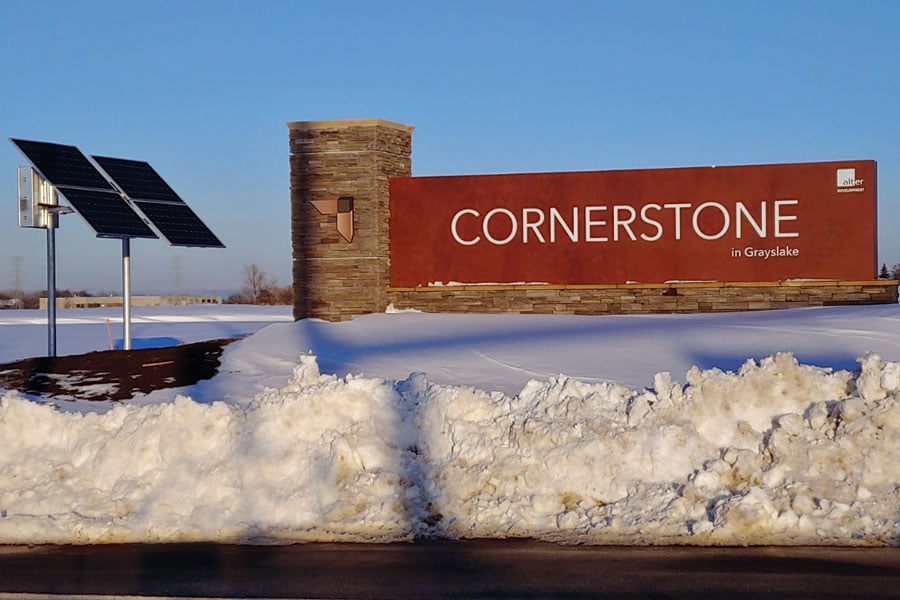
Large Monument/Pylon Signs
A larger monument or pylon sign serves as an impressive landmark, typically designed to signify the entrance to a significant area, such as a city, municipality, residential community, or homeowners association (HOA). These signs are functional and aim to enhance their surroundings' visual appeal, thereby creating a welcoming atmosphere.
To achieve full and effective illumination, these signs may require multiple light fixtures strategically positioned to illuminate the sign face and other landscape features. This lighting ensures that the sign remains visible and impactful day and night. These additional components contribute to the overall grandeur and attractiveness of the sign, making it a focal point that draws attention and admiration from passersby and enhances the identity of the area it represents.
Because of their larger nature, more power is required to operate multiple flood lights or LED modules inside a cabinet. For example, the Cornerstone photo referenced above is around 20' wide and internally illuminated. The load was around 100 Watts and installed in Illinois, which has only a few hours of workable sunlight in the winter, and the customer required all-night illumination. This was possibly by splitting the load and using two solar power systems to handle the load and provide reliable power for the sign.
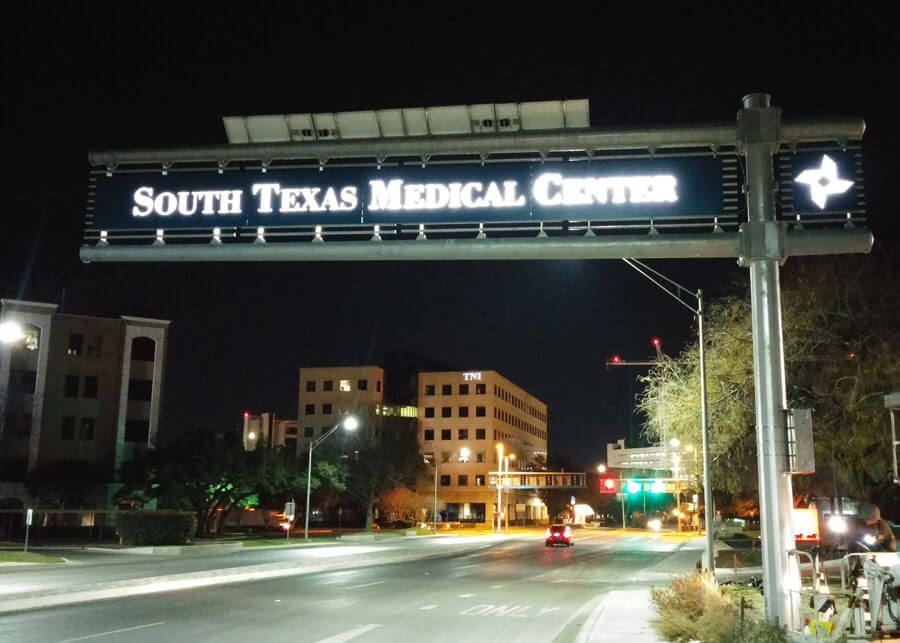
Sign Cabinets or Pole Signs
Sign cabinets or pole signs are similar to small directional and large monument signs, yet they have distinct characteristics that set them apart. These signs typically incorporate an acrylic panel, which serves as the surface where graphics and text are displayed. This panel is mounted onto the face of the sign cabinet, providing a smooth and professional appearance.
One of the key features of sign cabinets or pole signs is their internal illumination, which is almost exclusively achieved through the use of LED modules. This lighting method ensures the sign is visible and vibrant, capturing attention day and night. The internal LED illumination enhances the sign's aesthetic appeal and are easy to see, especially at night.
SEPCO has tested multiple LED modules for internal LED sign lighting systems and understands the requirements for efficient operation. Most LED modules on the market today do not handle fluctuations in the power provided by the batteries; however, by implementing a DC to DC converter, a straight 12 or 24 VDC is held to the LED modules. This ensures there is no fluctuation causing the LEDs themselves to run hotter or cooler depending on the battery voltage.
LED wattage ranges from 7 Watts to 110 Watts for most dusk to dawn applications; higher wattages are available with split time or dusk activated for x number of hours, depending on the system installation location. Depending on the installation location, wattage adjustments can be worked on with the sign manufacturer by changing the brand of LED modules to a more efficient module or removing and respacing the modules slightly to reduce power consumption to fit inside the solar scope.
These signs are practical in environments that require the same information to be displayed on both sides. This is often the case in areas like shopping centers, where visibility from multiple directions is crucial. The design of sign cabinets allows for easy updates and changes to the displayed information, making them highly adaptable for businesses that require regular sign updates.
Furthermore, sign cabinets' versatility makes them suitable for a variety of other applications, such as airports, business complexes, and entertainment venues, where clarity and adaptability of information are paramount.
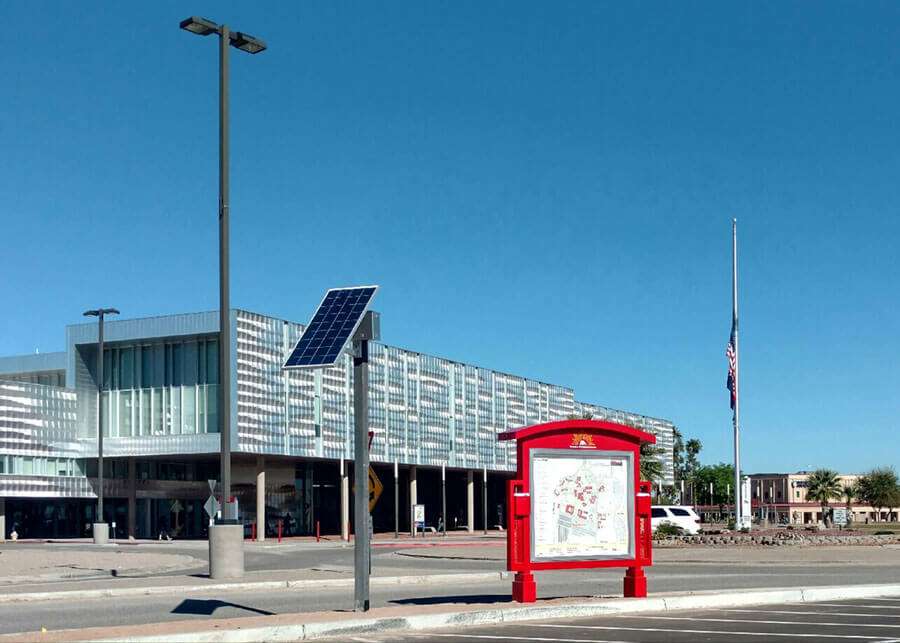
Kiosks
Sign kiosks are perfect for various public spaces, campuses, parks, airports, train stations, museums, and more, serving as essential information hubs. These versatile structures are designed to enhance the visitor experience by providing a wealth of information and services. They often offer clear directions, helping individuals navigate complex venues with ease and efficiency.
In addition to guiding visitors, sign kiosks play a crucial role in marketing by displaying vivid advertisements that promote nearby products or services, enticing potential customers with eye-catching visuals and compelling messages. They are instrumental in informing the public about upcoming events and offering details about concerts, exhibitions, or special promotions to ensure visitors are always aware of what's happening.
Structurally, these kiosks are typically outfitted with long linear lights or backlit panels, ensuring the information is easily visible and readable, even in low-light conditions. While some kiosks are designed with roofs to offer added protection from the elements, others may forgo this feature, depending on their location and intended use. Overall, sign kiosks are indispensable fixtures in public areas, combining functionality with modern design to serve a wide array of purposes.
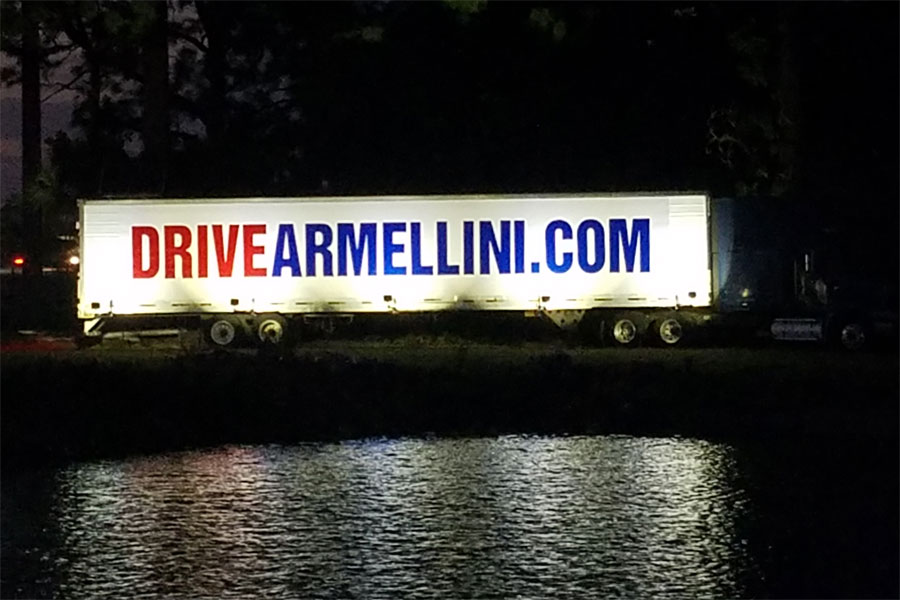
Billboards
Billboards are a great way to advertise your business for travelers on highways. But there are missed business opportunities if your billboards aren’t lit at night. Lighting these billboards can provide advertisement and information for nighttime travelers and is a great way to showcase your business, even after hours. There are design options to consider with every billboard to make sure that your billboard stands out.
Given their strategic placements, many billboards are situated on land that is not owned by the billboard company, which presents challenges in accessing traditional power sources. As a result, a significant number of billboards have adopted solar technology to meet their lighting needs. These billboards can operate independently of the electrical grid by harnessing solar power, providing a sustainable and cost-effective solution.
The size of billboards requires multiple lighting fixtures to ensure the entire surface is evenly illuminated, presenting the advertisement clearly and effectively, regardless of the time of day. However, due to their placement in remote areas with minimal ambient light pollution, the lighting requirements can be less intense, allowing for lower-level, energy-efficient LED light fixtures.
Having the lights shut off for a few hours during the middle of the night when there is little traffic will reduce the size of the solar power and battery assembly required to power the lights, reducing the overall cost of the system. Sometimes, multiple systems are required, each one powering a set number of fixtures, depending on the installation location and operation requirements.
This thoughtful use of solar technology reduces the environmental impact and ensures that the billboard remains visible to travelers, effectively delivering its advertising message at all hours.
Reasons Why You Should Illuminate a Sign
Having a sign installed is only the first step. After the installation, you should ensure the sign is properly illuminated. Illuminating a sign can provide several benefits:
- Visibility: Illuminating a sign makes it more visible, especially in low-light conditions or at night. This can be important for safety reasons, such as for traffic signs, directional signs, or emergency exit signs.
- Attract attention: Illuminated signs can help businesses or organizations draw attention to their location, products, or services and stand out in a crowded environment.
- Branding: Illuminated signs can also help reinforce a brand's identity and create a memorable impression on customers. For example, a well-lit and prominently displayed logo can help create a strong association between the brand and the product or service.
- Aesthetics: Illuminated signs can also enhance a location's aesthetic appeal, creating an inviting and welcoming atmosphere. This can be important for public spaces like parks, plazas, and shopping centers.
There are instances where traditional power cannot illuminate a sign, usually because of a lack of infrastructure at the sign location or because trenching out the electrical lines may be too costly. This is where a solar sign lighting system or custom solar power system can be used to provide the needed lighting or power to the sign. Let's review how these systems provide reliable power to ensure your sign shines bright.

Why Use Solar for Your Sign
Why should you consider using solar lighting for your next sign project? Solar lighting is ideal for situations where traditional power sources are unavailable or too expensive to install. For instance, installing a sign in the middle of a large roadway can be problematic if you need to trench power lines, as it may disrupt traffic and be costly to implement. Additionally, the expense of routing high-powered transmission lines can be significant.
Off-grid solar lighting systems are perfect for such scenarios, providing a dedicated power source for the sign. These systems use low-voltage DC power and inexpensive low-power lines, eliminating additional electric bills and reducing reliance on non-renewable energy sources.
Moreover, solar lighting is an excellent choice for businesses or communities aiming to highlight their commitment to sustainability. It offers a chance for companies to explore solar energy applications without committing to a large-scale grid-tied system. This allows them to gain insights into solar energy requirements, learn about the solar industry, and collaborate with experts who can offer guidance.
Sizing Up the Solar for Your Sign
Only a few steps and pieces of information are required to size up a solar solution for a sign. Since signs are quite simple, putting the system together is easy, unlike many other solar lighting applications. The information that needs to be gathered includes:
- Where is the sign going to be installed?
- This information allows the designer to gather the local area's solar insolation, length of night, and any crucial weather information.
- What are the dimensions of the sign?
- This allows the designer to understand the overall dimensions of the flood-illuminated sign or to provide some understanding of how an internal cabinet will need to be laid out.
- Will the sign be illuminated by floods or LED modules/sticks?
- If flood illuminated, is the sign single or double-sided?
- If internally illuminated, what model of LED module and how many?
- How long per night does the sign need to operate?
- Dusk to dawn is always the initial go-to for many applications; however, reducing the operation so that the lights shut off when the area is inactive will help reduce the system sizing and cost.
- Any other requirements or restrictions for the project?
- In this case, the designer is looking for solar mounting options, finish options, or any other requirements such as UL/CSA/ETL listings, BABA or BAA Requirements, and more.
Let's explore each question a little more deeply and explain why this information is critical to developing the correct system to meet the project's needs.
Where is the sign going to be installed?
Requesting the project's installation location helps to gather the available solar insolation, sun hours, and the length of night in the location. Understanding how much solar is available at the location will govern the entire project. Areas with more solar availability can operate at a much higher wattage than areas with less sun. Sometimes multiple solar units are used to illuminate large signs, like large internally illuminated signs or large billboards.
The other reason for the location is to see if there are any obstacles to the solar. This includes shading concerns, southern exposure, and just a general idea of the best location for the solar unit. Sometimes, the solar panels can be placed right next to the sign; however, there are a few cases where the sign is located in a space with lots of landscaping, trees, and even buildings. These systems must be located further away to ensure the panels are not shaded during the daytime.
Finally, understanding the sign's location allows the designer to consider other design aspects, like ambient light. The more ambient light, the higher-powered lights should be used, whereas, in lower ambient or more remote locations, lower-wattage fixtures or modules can be used.
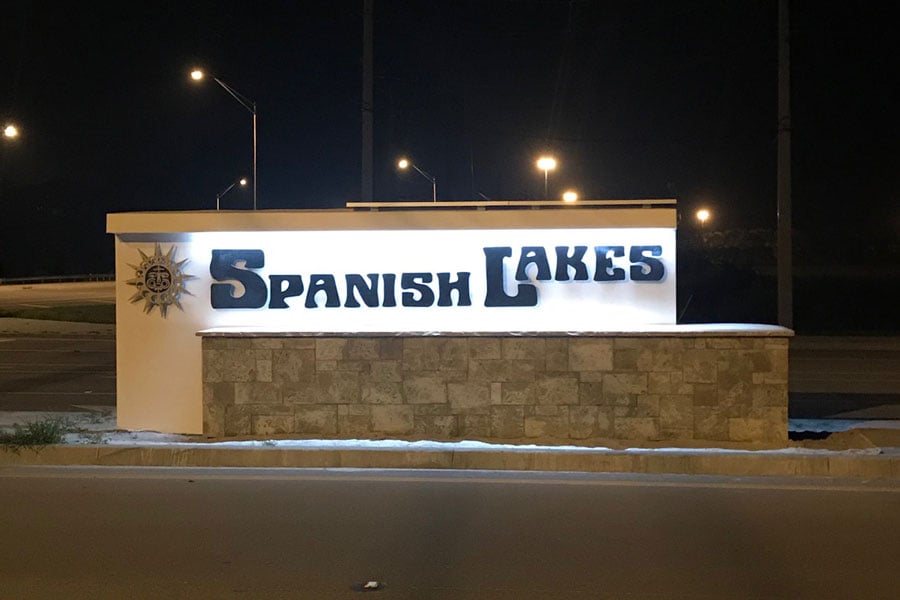
What are the sign's dimensions?
Understanding the sign's dimensions is key for flood lighting a sign. Most floodlights offer good coverage for 10-foot square areas with a wattage range of 10-25 Watts, with higher wattage fixtures used in higher ambient light areas. This depends on many factors but is an excellent general rule of thumb and a great place to start when designing the system.
If the sign is smaller, single fixtures can be used with lower wattages because the fixture setback isn't as far as larger signs. For example, if you have a 4' high x 6' wide sign, the fixture doesn't need to be placed more than 2-3' away from the sign and will adequately illuminate the sign face; however, if you are looking at a 6' high x 10' wide sign, the fixture either needs to be installed 3-4' away from the sign face or two fixtures are used if the setback is less.
Sign schematics help determine the best type of setup for floods and allow the designer to provide lighting layouts to show the light levels on the sign. These schematics also help with internally illuminated sign cabinets, as the designer can help find the most efficient LED module to illuminate the cabinet.
Finally, if the sign is single-sided, only one or two fixtures will be used. However, if it is double-sided, ensuring enough fixtures or modules are used to illuminate both sides of the sign properly is critical.
Floods or LED Modules
There are two main ways to illuminate a sign: floods, like those mentioned above, and LED modules for internal illumination or halo glow. Due to the nature of how internal signs work, LED modules tend to have a higher power requirement. Many LED modules are needed to illuminate the same area one flood typically can cover, making them a more costly system to design. Understanding modules and their efficiencies is critical when working with LED modules.
Internal LED modules, like those from Principal/Sloan/Hanley, GE, G2G, or another manufacturer, would be powered directly by the DC power provided by the solar; no AC power would be used. This allows for the power supply to be removed and the actual wattage is calculated to determine the solar. A DC-to-DC converter is used to regulate the DC power from the batteries and to either step up or down the power to meet the LED module's needs. However, this is not standard for most sign companies, so working with a solar professional to assess the needs of the sign and how to adjust it to meet the solar requirements better is key to providing the correct system.
How Long to Light the Sign
Some signs require dusk-to-dawn illumination because of their nature, such as entrance signs to cities, municipalities, communities, or other such spaces. Other signs, like those of office spaces, can be shut off after midnight or so, depending on the area's traffic. Signs are great for marketing, but most companies are closed after midnight and do not need to advertise afterward.
Having a sign illuminated from dusk to dawn typically uses the largest solar power assembly to operate, whereas having the lights shut off after a set time reduces the solar requirement. The reduction in solar can make or break a project financially. Working with a reputable solar designer will help ensure that the system is designed as efficiently as possible while also providing long-term operation and reliability.
Everything Else
All other project requirements and restrictions should be presented to the solar professional at the beginning of the project. This allows them to consider everything that will need to be dealt with, either with system sizing, operation, placement of solar, etc. Changing the specification because something was forgotten or changed later on can cause issues and miscommunications. The information includes things like finishes of the metalwork, mounting heights of the solar system, types of poles required, UL/CSA/ETL requirements, BABA or BAA requirements, and more. Likewise, changing the system operation or requirements after the system has been purchased and installed can cause problems for the customer since the system may not work as designed.
Commercially Design Systems vs. Big Box Retailers
There are two types of solar sign lighting solutions on the market today – one manufactured by a custom manufacturer like us here at SEPCO and online or big box retailers that import their products with a mentality that one size fits all. This has caused waves of frustration in the solar industry, where people install cheap systems that aren't appropriately designed; when they don't work, they tell everyone that solar energy doesn't work. Solar works, but you must be more diligent when designing an off-grid solution.
Commercially designed systems consider every piece of information when sizing up the system. The manufacturer looks at details that are often overlooked by people who do not work in the solar industry. Even some in the grid-tied solar sector do not entirely understand the details of the off-grid solar industry. This attention to detail ensures that the system will operate properly and will not have issues. Most reputable manufacturers provide longer warranty periods and better customer support for future maintenance.
Large retailers and online sellers lack the motivation to provide system support. Their primary focus is profit, and they often abandon customers when problems occur. These retailers typically direct customers to contact manufacturers, who are frequently either unknown or have undergone many changes, so obtaining support becomes nearly impossible. Making sure you purchase a system from a company that has been in business for as long as, or longer than, their systems are warrantied for will guarantee that they will stand behind their product and have the ability to service and assist installed systems for many years to come.
In conclusion, sign lighting is essential for visibility, safety, and branding. Illuminated signs can attract attention, reinforce a brand's identity, and create an inviting atmosphere. Solar-powered lighting is an excellent solution for ensuring a sign is well-lit, even in areas where access to electricity is limited or unreliable.
In addition, solar sign lighting is an eco-friendly and cost-effective option for lighting signs by harnessing the sun's power. They can qualify for most solar incentives and promote a green image. Furthermore, they can be easily installed without expensive infrastructure and maintenance costs. Overall, solar sign lighting is an effective and sustainable solution for illuminating signs, improving their visibility and ensuring they serve their intended purposes effectively.
Integrating Landscape Lighting with your Solar Sign Light
Signs are sometimes installed alone, while others are installed with landscaping, such as trees and shrubs. Integrating landscape floodlights with the sign lighting system is a great way to showcase the landscape at night. Best of all, with a commercial solar sign lighting system, integrating the additional landscape lights is easy with the same solar power assembly.
Most signs are either illuminated by floodlights or internal LED modules. The signs can either be single-sided or double-sided. The solar power assembly is sized up to operate the floods or LED modules for a set period, either dusk for several hours or all night. Sizing up some additional floods for landscapes is an easy way to illuminate the landscapes around the sign’s installation area. Since most of these smaller floods are very low wattage, the additional load to a solar power system isn’t too substantial to significantly affect the sizing.
Let’s look at a few projects that showcase this type of lighting well.
Las Ventanas HOA
The Las Ventanas HOA wanted a bright solar lighting fixture to illuminate their sign and some extra fixtures to illuminate the landscape around the stone entrance sign. We used a 10-watt LED flood fixture and three 3.4-watt small flood fixtures to illuminate the landscape. A single small solar power assembly powered everything from dusk for 6 hours.
Since this project was in a remote location with no ambient light, we could use a much lower wattage and provide good illumination. The photo doesn’t do the project justice as the sign looks too bright, and the landscape is well-lit; however, the customer was happy with the installation.

Welcome to Martin County
The Welcome to Martin County signs around our small county mostly have just the signs illuminated by our solar power systems; however, a few also have some landscape lights for the trees behind the signs. These systems are much larger as they have more lights at a much higher wattage than other projects.
Martin County started with compact fluorescent fixtures, but as technology evolved, they transitioned to LEDs. The LED fixtures provide much better lighting than the old-style lights using the same solar power assemblies. The new flood fixtures were upgraded as the old-style lights started to need replacing.
Orchid Bay HOA
Our newest project, which features sign and landscape lighting in one system, would be Orchid Bay HOA. This project features three ingrade bullet lights mounted behind the sign to shine up at the large trees while the single flood fixture illuminates the sign all night. In addition, this project showcases a single small solar power assembly as the lights are much lower wattage but still very high in lumen output.
The lower wattages can be used in remote applications such as the above; however, where more ambient light exists, like the Welcome to Martin County signs, higher wattage and larger solar power assemblies are required. Also, these three projects are all located with good sun, even in the winter. The same setups will require a more extensive solar power assembly in northern climates, but the same overall illumination is available.
Operation and Implementation
Larger systems are typically required to operate these projects from dusk to dawn; however, the floods' low power requirement allows many fixtures to operate off a single solar panel. The highest-wattage fixture is typically the sign; the rest are half the wattage or lower.
Another consideration is the installation. Since most fixtures need to be installed in the shade, like at the Wawa landscape lighting project, remotely installing the solar power assembly allows the solar to capture plenty of sun to charge the batteries fully. The low-voltage wire can be installed around the area to bring power to these fixtures, even when located directly under the tree. This type of system is unavailable with many off-the-shelf solar systems you can find online.
In conclusion, solar sign lighting offers a versatile and sustainable solution for illuminating signs, enhancing their visibility, and ensuring they effectively communicate their intended messages. By harnessing solar energy, these systems provide an eco-friendly and cost-effective alternative to traditional power sources, making them ideal for locations where electricity access is limited or costly. The benefits of solar sign lighting extend beyond environmental impact, offering businesses and communities a chance to showcase their commitment to sustainability while reducing operational costs.
To take advantage of these benefits, consider evaluating your current signage needs and exploring solar options tailored to your specific requirements. Collaborate with a reputable solar professional to design a system that meets your illumination goals and integrates seamlessly with your existing infrastructure. Doing so can ensure that your signs remain a beacon of information and branding, day and night while contributing to a greener future.



